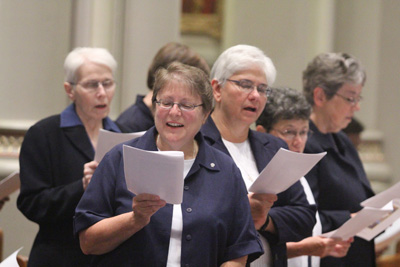
Daughters of Charity sisters sing a hymn together at the anniversay Mass celebrated Oct. 4 by Archbishop Charles Chaput at the Miraculous Medal Shrine in Germantown, Philadelphia. (Sarah Webb)
The Book of Job is not especially cheerful reading, at least not until near the very end, verse 15 of chapter 42: “In all the land no other women were as beautiful as the daughters of Job.”
That was part of the first reading on Oct. 4, the date the Daughters of Charity chose to celebrate the 200th anniversary of their arrival in Philadelphia as the very first congregation of women religious to minister in the city.
Archbishop Charles Chaput, the celebrant and homilist of the anniversary Mass at the Miraculous Medal Shrine in Germantown, said, “In all of the land no women are as beautiful as the daughters of St. Louise and St. Vincent,” referring to St. Vincent de Paul and St. Louise de Marillac, the co-founders of the Daughters of Charity in 17th-century France.
(See a photo gallery from the Mass here.)
[hotblock]
Their beauty, the archbishop said, stems from their fidelity to their faithfulness to their founding charism: service to the poor. By chance, Oct. 4 also happens to be the Feast of St. Francis of Assisi, the founding father of the Franciscans of which Archbishop Chaput, as a Capuchin Franciscan, is a member. He noted the similarities between St. Vincent and St. Francis, who not only practiced charity but embraced poverty himself.
The Daughters of Charity in Philadelphia trace directly back to the Sisters of Charity of St. Joseph founded in 1809 in Baltimore by St. Elizabeth Ann Seton, who like St. Louise was a widowed mother before embracing the religious life. Her first postulant was Cecilia O’Conway, a Philadelphian, and in 1810 after the sisters moved to Emmitsburg with assistance from the Sulpician Fathers, Mother Seton adopted a modified form the rule of the French Daughters of Charity for her new order.
In 1814, at the request of Augustinian Father Michael Hurley, pastor of St. Augustine Church, Mother Seton sent three Sisters to Philadelphia to take charge of a small orphanage, the St. Joseph Orphan Asylum. The orphanage had been established in 1797 initially to care for Catholic children orphaned by the series of disastrous Yellow Fever epidemics that plagued Philadelphia in that era.
The St. Joseph Orphan Asylum, then located adjacent to Holy Trinity Church in old city Philadelphia with 13 children of both sexes, was the first organized Catholic social outreach program in what is now the Archdiocese Philadelphia.
Because the trustees were dissatisfied with the level of care supplied by the hired staff the request was made to Mother Seton. Mother Rose White and Sisters Teresa Conroy and Susan Clossy left Emmitsburg, Md., Sept. 29, 1814.
[hotblock2]
They were the very first sisters sent out on mission by Mother Seton and they arrived in Philadelphia on Oct. 6. They did not travel by boat which would have been faster than land because of danger from the British naval vessels operating in the coastal waters during the ongoing War of 1812.
In spite of initial difficulties the sisters persevered. As the institution grew it was split into separate homes for girls and boys, with the Sisters of Charity remaining with the girls, through several locations until 1984 when St. Joseph’s Hall for Girls closed. Other schools and hospitals followed in the early years.
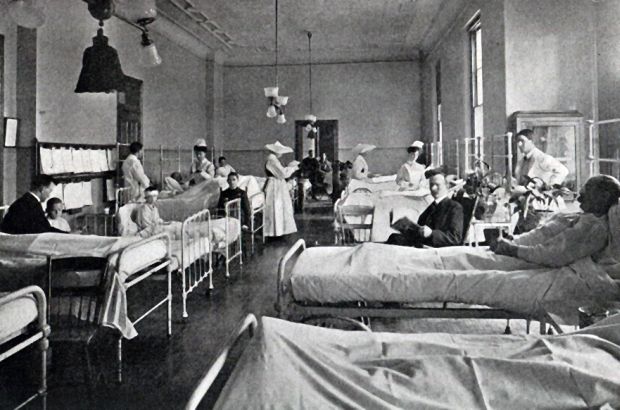
Daughters of Charity staff the men’s surgical ward of the former St. Joseph’s Hospital in Philadelphia, in 1907.
In the 1850s the Sisters of Charity in many areas, including Philadelphia, became officially affiliated with the Daughters of Charity in France and the name of the congregation changed to the Daughters of Charity of St. Vincent de Paul and the distinctive French habit was adopted.
During the Civil War the Daughters were asked to staff the vast 2,500-bed Satterlee Army Hospital in West Philadelphia. Forty sisters served in this unique temporary wartime mission, led by Sister Mary Gonzaga who ministered in Philadelphia for almost 70 years until her death in 1897.
Prior to the Civil War some sisters did teach in schools, but after the war they focused almost exclusively to work among the poor, the elderly and sick.
Other 19th-century ministries included St. Joseph’s Hospital on Girard Avenue which they conducted until 1947, St. Vincent’s Home and Maternity Hospital, first on Woodland Avenue later in Drexel Hill, now the site of Msgr. Bonner-Archbishop Prendergast High School.
Many of the women served by the maternity hospital were very poor, and if the mothers were unwed often their baby would remain at the orphanage. If they were girls some might remain through their childhood; other children at age 5 or so would be passed on mostly to single-sex orphanages.
The scope of this ministry is indicated by an 1895 history that shows 1,071 children passed through the orphanage the previous year and 411 were baptized at the hospital; they would often be the children that remained at the orphanage.
Over the two centuries more than 1,000 Daughters of Charity have served in the Archdiocese of Philadelphia but as in virtually all religious congregations recently in greatly reduced in numbers with 10 sisters missioned to Philadelphia at this time. They are part of the almost 500-member St. Louis-based Province of St. Louise and worldwide, Daughters of Charity number about 17,000.
Sister Louise Galahue, the Visitrix for the Province of St. Louis, was among the Daughters of Charity and Vincentians who came to the Miraculous Medal Shrine for the celebration.
“We are proud of St. Elizabeth Ann Seton and Vincent really armed her to be a servant of the poor,” she said, adding, “We take four vows: poverty, chastity, obedience and service to the poor.”
Because Philadelphia was the first place St. Elizabeth sent her sisters, “we grew up with the Church in Philadelphia,” Sister Louise said.
Currently Daughters of Charity of St. Vincent de Paul serving in Philadelphia, with Sister Mary Frances Martin as their local superior, work for the most part in the Germantown area, as do their spiritual brothers, the Vincentian Fathers and Brothers.
Sisters minister at De Paul Catholic School, St. Vincent de Paul Center for Youth and Young Adults, St. Vincent’s Seminary, Dawn’s Place (a shelter for sexually trafficked women) and De Paul House USA (a temporary shelter for homeless men).
St. Vincent and St. Louise must be very proud of them.
PREVIOUS: Little Flower marks 75 years of its special link to a saint
NEXT: Black Catholics’ traditional home in archdiocese to close



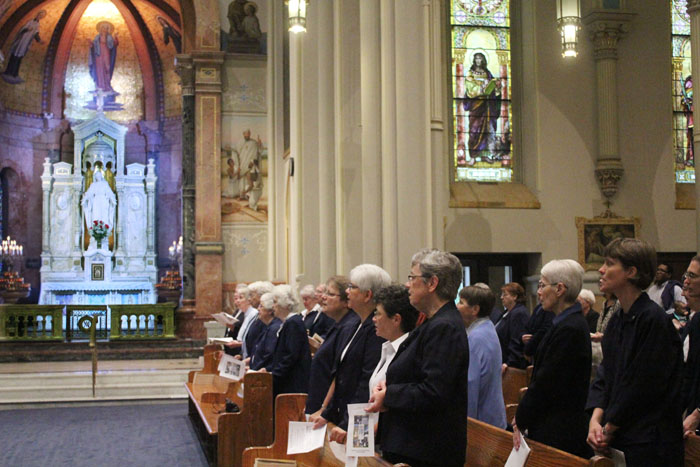
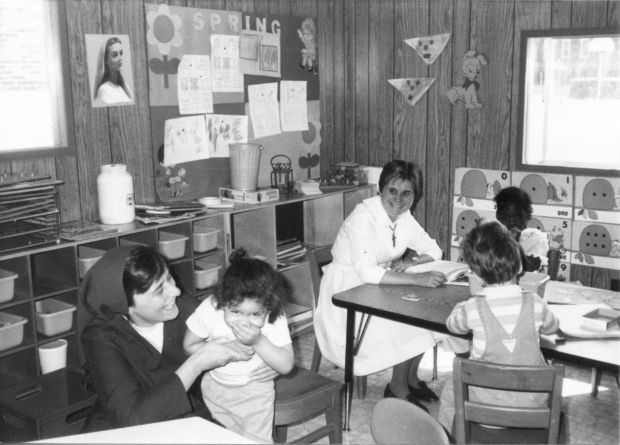
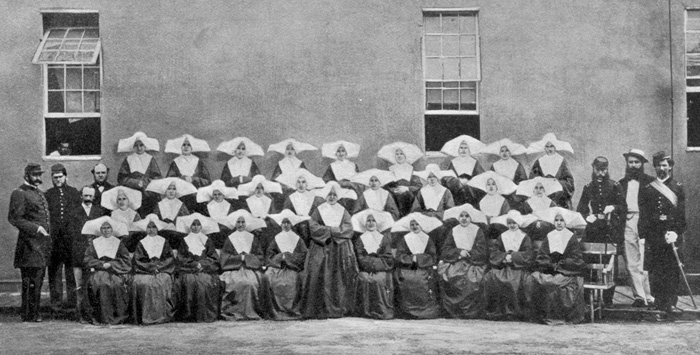
Good morning, Is there I way that I could find records from the early 1900’s for St Vincent’s Home for Girls/Unwed mothers?
I’m looking for a lost relative. The remaining family would be so happy and relieved.
Thank you!
To Ella Ennis Rusk, thank you for your kind remembrance of Sister Baptista. She was my mothers older sister.She passed away in the early 2000’s at the age of 95 or 96 at a retirement home for the Daughters of Charity in Albany N.Y.Me and all of my family loved her very much and have fond memories of her.A very special lady!
What ever happend to sister joyce birn nov 9 1923 the woman that adopted me my mother i say with much love was born same day and sister Barthalumu who helped
I was at saint joseph in late 60s adopted on december 3. 1972 my name was Rhonda Jo johnson
I lived at the “Gonzaga” with my 3 sisters, Maggie, Kathy, and Josie from 1950 till 1952. Great place! Great nuns!
Hello Ella, I was in Gonzaga from approx. 1952-1961. I have been researching Gonzaga and what happened to her for a few years while trying to revisit my childhood. I know the grand old lady of a building was demolished and a new smaller modular type facility replaced the original building and then that building was closed. You were just arriving as I was leaving and must have gone to Alleghany Ave before the demolition. I kept in touch with Sister Emelia for awhile but then lost contact. Don’t have much information but determined to keep at it. Went to revisit the site a few years ago. The land is now vacant, all buildings gone just the memory carries on.
Just reading things bout St Joseph Gonzaga Home for girls. I was in this home from bout 61 till 64. Then went to St Joseph for girls, 29 th and Allegheny ave. In Philly. Was wondering what had happened to them . any information or anything bout them would be most appreciated. I had some of the best sisters. I remember Sister Baptista, she was my role model. Sister Helen, not so much. But they made my future much brighter then it would of been. I was placed there by social services at 10. Best thing for me. Any news or info, most appreciated. I was Ella Ennis. Today my last name is Rusk.